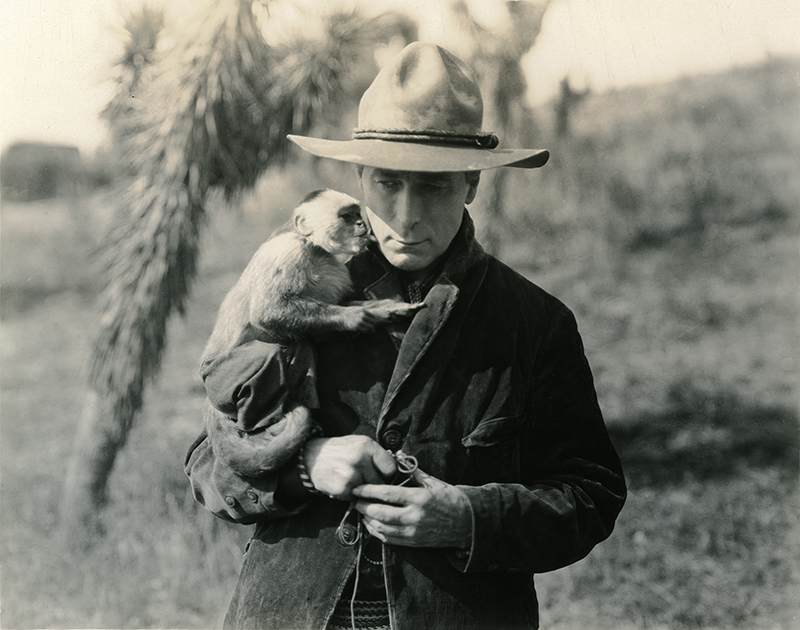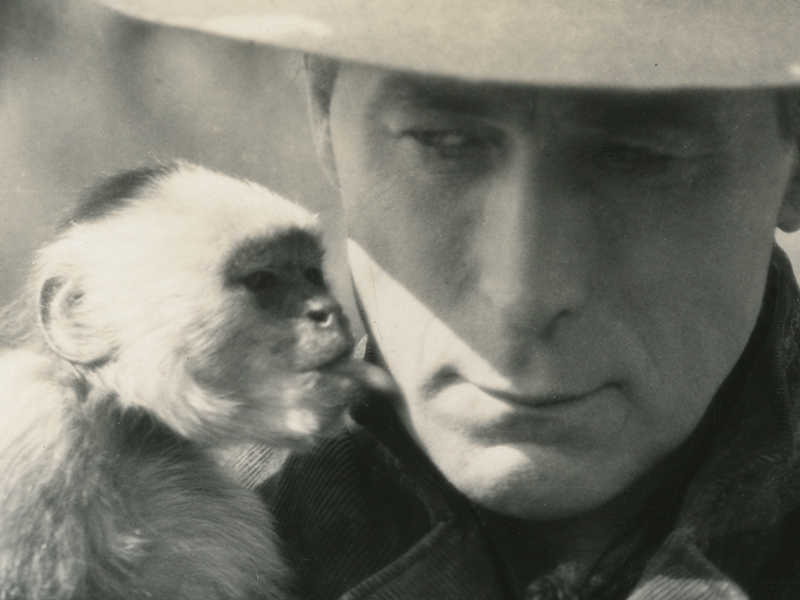"Travelin' On"
With William S. Hart & Jocko the Monkey

Click image to enlarge
| Download archival scan
Jocko the Monkey gets a taste of fame and fortune — literally — in this original, unnumbered 8x10 publicity still from 1922's "Travelin' On" from Paramount-Artcraft, directed by Lambert Hillyer from an original story by William S. Hart (shown). Read it here. In the story, Hart's character receives the monkey from a Spanish dance hall girl named Carmen Rosa; after all, what Spanish dance hall girl isn't named Carmen and doesn't have a pet capuchin monkey? This wasn't the first monkey to be named Jocko — the name appears in literature in the 1830s — but this one was the most famous, inspiring several lines of hand puppets and other toys. It seemed that anyone who had a pet monkey afterward just had to name it Jocko. This Jocko appeared in several films in the early 1920s including the 1925 screen adaptation of Sir Arthur Conan Doyle's "The Lost World" and the 1927 Harold Lloyd comedy, "The Kid Brother" — which are easier to come by today than "Travelin' On," although prints of the Hart film are said to reside in the Library of Congress collection and the Museum of Modern Art in New York.
About "Travelin' On," the Motion Picture. From Koszarski (1980:137): Produced by the William S. Hart Company; distributed by Paramount-Artcraft; released March 11, 1922; ©February 24, 1921; seven reels (6267 feet). Directed by Lambert Hillyer; screenplay by Lambert Hillyer from the story "J.B. the Unbeliever" by William S. Hart; photographed by Joe August; art director, J.C. Hoffner; art titles by Harry Barndollar. (Note: "J.B. the Unbeliever" might have been a working title of the picture, but the original short story, per Hart, is titled "Travelin' On.") CAST: William S. Hart (J.B.); James Farley (Dandy Allen McGee); Ethel Grey Terry (Susan Morton); Brinsley Shaw (Hi Morton); Mary Jane Irving (Mary Jane Morton); Robert Kortman (Gila); Willis Marks ("Know-It-All" Haskins); Fritz ("Spots"); Jocko the Monk (as himself). SYNOPSIS: J.B., a Western wanderer, reaches the town of Tumble Bluff about the same time as Hi Morton, a zealous preacher. McGee, who owns the saloon and dance hall, resents the preacher's presence and also incurs the enmity of J.B., who does not trust him. Both McGee and J.B. covet Morton's wife, but she resists their advances. J.B. rescues her from McGee and then sees himself as he really is. [On a stormy night J.B. goes in search of the monkey given to him by a dance-hall girl. While he is gone Morton borrows "Spots," J.B.'s pinto horse. Riding the horse,] Morton, who was formerly a highwayman, holds up the stage coach to get money to finish the church. He is arrested and sentenced to be hung. J.B., to save the woman he loves, thereupon assumes the guilt, frees Morton and then makes his escape. [Moving Picture World, March 25, 1922] REVIEWS: Travelin' On seems slower and a bit below the average of pictures usually offered by Hart. ... this one is not nearly as full of action and sure-fire situations as most of the others. The picture is over six reels and the story, written by Hart, doesn't contain sufficient situations to carry it over five reels. ... [He] has written much better stories and while he has provided himself with a good part, the others are not strong ... a good deal of padding such as the prominence given the monkey, and the numerous titles ... help consume the six reels. Travelin' On is said to be the star's last picture, or at least the last one which Paramount will release unless a new contract is made. ... [Wid's, March 19, 1922] Typical William S. Hart production — fitly describes this star's latest Paramount feature, Travelin' On. It compares favorably with any of his recent productions and should prove perfectly satisfactory to lovers of Westerns and admirers of William S. Hart in particular ... there are a number of thrilling moments in the story, particularly where the hero on successive occasions saves himself by his unusual quickness on the draw. ... [C. S. Sewell, Moving Picture World, March 25,1922]
LW3649: 9600 dpi jpeg from original photograph purchased 2019 by Leon Worden.
|




